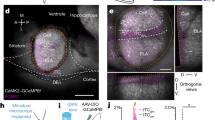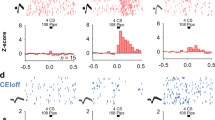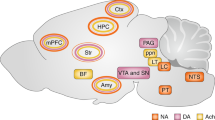Abstract
The amygdala has long been thought to be involved in emotional behaviour1,2, and its role in anxiety and conditioned fear has been highlighted3,4. Individual amygdaloid nuclei have been shown to project to various cortical and subcortical regions implicated in affective processing5,6,7. Here we show that some of these nuclei have separate roles in distinct mechanisms underlying conditioned fear responses. Rats with lesions of the central nucleus exhibited reduction in the suppression of behaviour elicited by a conditioned fear stimulus, but were simultaneously able to direct their actions to avoid further presentations of this aversive stimulus. In contrast, animals with lesions of the basolateral amygdala were unable to avoid the conditioned aversive stimulus by their choice behaviour, but exhibited normal conditioned suppression to this stimulus. This double dissociation demonstrates that distinct neural systems involving separate amygdaloid nuclei mediate different types of conditioned fear behaviour. We suggest that theories of amygdala function should take into account the roles of discrete amygdala subsystems in controlling different components of integrated emotional responses.
This is a preview of subscription content, access via your institution
Access options
Subscribe to this journal
Receive 51 print issues and online access
$199.00 per year
only $3.90 per issue
Buy this article
- Purchase on Springer Link
- Instant access to full article PDF
Prices may be subject to local taxes which are calculated during checkout



Similar content being viewed by others
References
Weiskrantz, L. Behavioural changes associated with ablations of the amygdaloid complex in monkeys. J. Comp. Physiol. Psychol. 49, 381–391 (1956).
Kluver, H. & Bucy, P. C. Preliminary analysis of the temporal lobes in monkeys. Arch. Neurol. Psychiat. 42, 979–1000 (1939).
Davis, M. The role of the amygdala in fear and anxiety. Annu. Rev. Neurosci. 15, 353–375 (1992).
LeDoux, J. The Emotional Brain(Simon and Schuster, New York, (1996)).
Davis, M., Hitchcock, J. M. & Rosen, J. B. Anxiety and the amygdala: Pharmacological and anatomical analysis of the fear-potentiated startle paradigm. Psychol. Learn. Motiv. 21, 263–305 (1987).
LeDoux, J. E. Emotion: Clues from the brain. Annu. Rev. Psychol. 46, 209–235 (1995).
Kapp, B. S., Pascoe, J. P. & Bixler, M. A. in The Neuropsychology of Memory(eds Butters, N. & Squire, L.S.) 473–488 (Guildford, New York, (1984)).
Gallagher, M. & Chiba, A. A. The amygdala and emotion. Curr. Opin. Neurobiol. 6, 221–227 (1996).
Everitt, B. J. & Robbins, T. W. in The Amygdala: Neurobiological Aspects of Emotion, Memory and Mental Dysfunction(ed. Aggleton, J. P.) 401–429 (Wiley-Liss, New York, (1992)).
Bouton, M. E. & Bolles, R. C. Conditioned fear assessed by freezing and by the suppression of three different baselines. Anim. Learn. Behav. 8, 429–434 (1980).
Mowrer, O. H. & Solomon, L. N. Contiguity vs. drive-reduction in conditioned fear: The proximity and abruptness of drive reduction. Am. J. Psychol. 67, 15–25 (1954).
Selden, N. R. W., Everitt, B. J., Jarrard, L. E. & Robbins, T. W. Complementary roles for the amygdala and hippocampus in aversive conditioning to explicit and contextual cues. Neuroscience 42, 335–350 (1991).
Sananes, C. B. & Davis, M. N-Methyl-D-Aspartate lesions of the lateral and basolateral nuclei of the amygdala block fear-potentiated startle and shock-sensitization of startle. Behav. Neurosci. 106, 72–80 (1992).
Maren, S., Aharonov, G. & Fanselow, M. S. Retrograde abolition of conditional fear after excitotoxic lesions in the basolateral amygdala of rats: Absence of a temporal gradient. Behav. Neurosci. 110, 718–726 (1996).
Parent, M. B., Tomaz, C. & McGaugh, J. L. Increased training in an aversively motivated task attenuates the memory-impairing effects of posttraining N-Methyl-D-Aspartate-induced amygdala lesions. Behav. Neurosci. 106, 789–797 (1992).
Amaral, D. G., Price, J. L., Pitkanen, A. & Carmichael, S. T. in The Amygdala: Neurobiological Aspects of Emotion, Memory and Mental Dysfunction(ed. Aggleton, J. P.) 1–66 (Wiley-Liss, New York, (1992)).
Thompson, R. F. & Krupa, D. J. Organization of memory traces in the mammalian brain. Annu. Rev. Neurosci. 17, 519–549 (1994).
Wan, F. J. & Swerdlow, N. R. The basolateral amygdala regulates sensorimotor grating of acoustic startle in the rat. Neuroscience 76, 715–724 (1996).
Groenewegen, H. J., Berendse, H. W., Wolters, J. G. & Lohman, A. H. M. The anatomical relationship of the prefrontal cortex with the striatopallidal system, the thalamus and the amygdala: evidence for a parallel organization. Prog. Brain Res. 85, 95–118 (1990).
Damasio, A. Descartes' Error(Putnam, New York, (1994)).
Bechara, A., Tranel, D., Damasio, H. & Damasio, A. R. Failure to respond autonomically to anticipated future outcomes following damage to prefrontal cortex. Cereb. Cortex 6, 215–225 (1996).
Everitt, B. J., Morris, K., O'Brien, A. & Robbins, T. W. The basolateral amygdala-central striatal system and conditioned place preference: Further evidence of limbic-striatal interactions underlying reward-related processes. Neuroscience 42, 1–18 (1991).
Bechara, A. et al. Double dissociation of conditioning and declarative knowledge relative to amygdala and hippocampus in humans. Science 269, 1115–1118 (1995).
Cahill, L., Babinsky, R., Markowitsch, H. J. & McGaugh, J. L. The amygdala and emotional memory. Nature 377, 295–296 (1995).
Cahill, L. et al. Amygdala activity at encoding correlated with long-term, free-recall of emotional information. Proc. Natl Acad. Sci. USA 93, 8016–8021 (1996).
Adolphs, R., Tranel, D., Damasio, H. & Damasio, A. Impaired recognition of emotion in facial expressions following bilateral damage to the human amygdala. Nature 372, 669–672 (1994).
Calder, A. J. et al. Facial emotion recognition after bilateral amygdala damage: Differentially severe impairment of fear. Cogn Neuropsychol. 13, 699–645 (1996).
Scott, S. K. et al. Impaired auditory recognition of fear and anger following bilateral amygdala lesions. Nature 385, 254–257 (1997).
Mowrer, O. H. On the dual nature of learning—A re-interpretation of “conditioning” and “problem-solving”. Harvard Educat. Rev. 17, 102–148 (1947).
Swanson, L. W. Brain Maps: Structure of the rat brain(Elsevier, Amsterdam, (1992)).
Acknowledgements
We thank C. Morrison and H. Sweet for help with histology. This work was supported by a grant from the Human Frontiers Science Program, and a research fellowship to S.K. from Magdalene College, Cambridge.
Author information
Authors and Affiliations
Corresponding author
Rights and permissions
About this article
Cite this article
Killcross, S., Robbins, T. & Everitt, B. Different types of fear-conditioned behaviour mediated by separate nuclei within amygdala. Nature 388, 377–380 (1997). https://doi.org/10.1038/41097
Received:
Accepted:
Issue Date:
DOI: https://doi.org/10.1038/41097
This article is cited by
-
Liposaccharide-induced sustained mild inflammation fragments social behavior and alters basolateral amygdala activity
Psychopharmacology (2023)
-
Refinement of the stress-enhanced fear learning model of post-traumatic stress disorder: a behavioral and molecular analysis
Lab Animal (2022)
-
Instrumental aversion coding in the basolateral amygdala and its reversion by a benzodiazepine
Neuropsychopharmacology (2022)
-
Reciprocal cortico-amygdala connections regulate prosocial and selfish choices in mice
Nature Neuroscience (2022)
-
Behavioral and brain mechanisms mediating conditioned flight behavior in rats
Scientific Reports (2021)
Comments
By submitting a comment you agree to abide by our Terms and Community Guidelines. If you find something abusive or that does not comply with our terms or guidelines please flag it as inappropriate.



